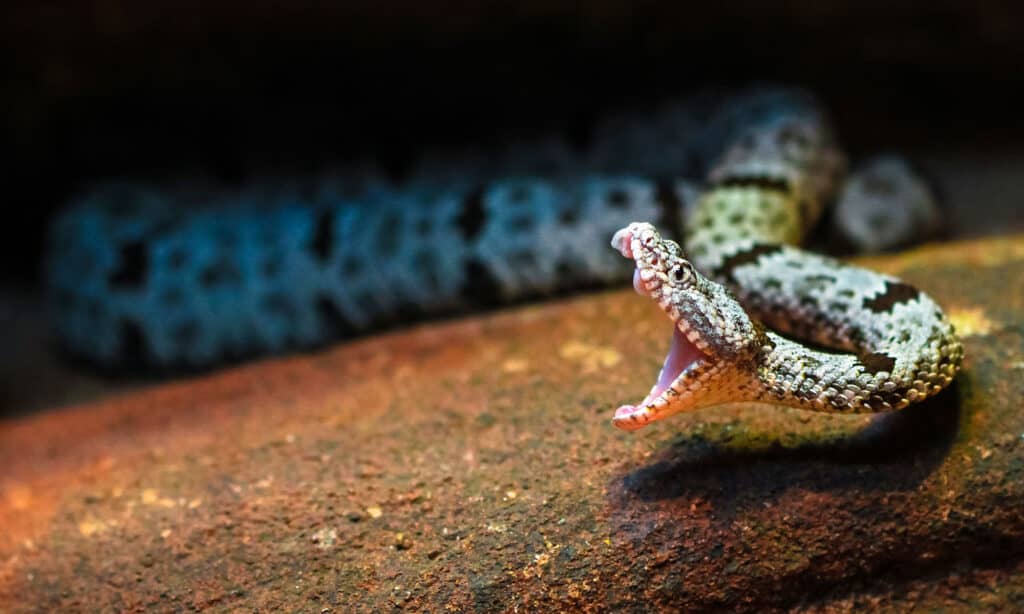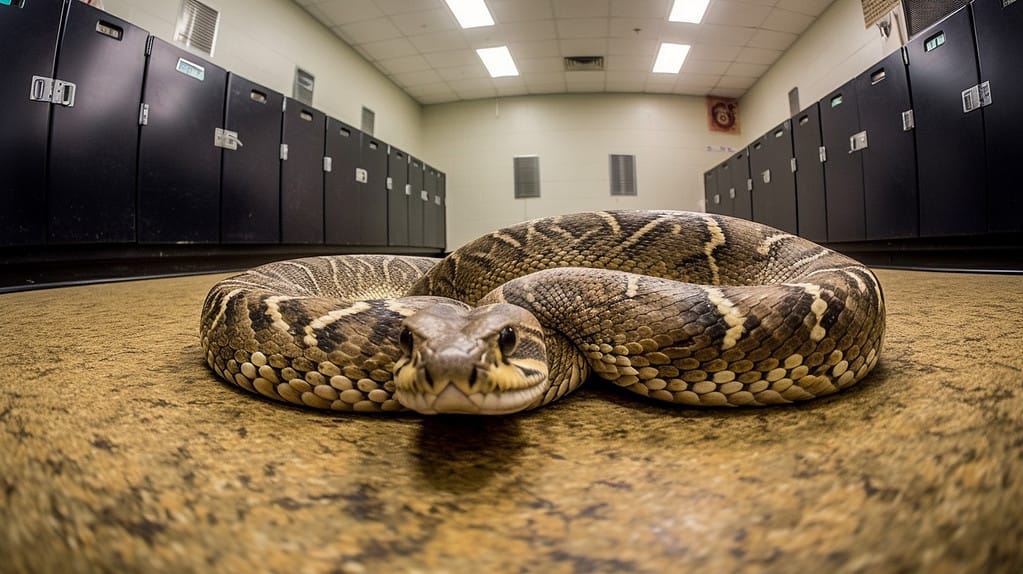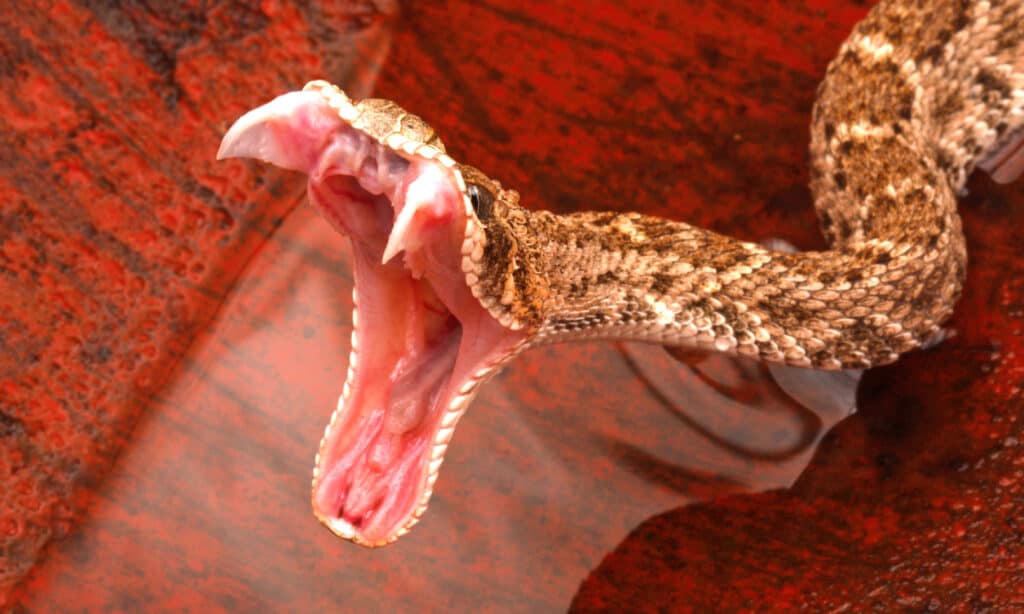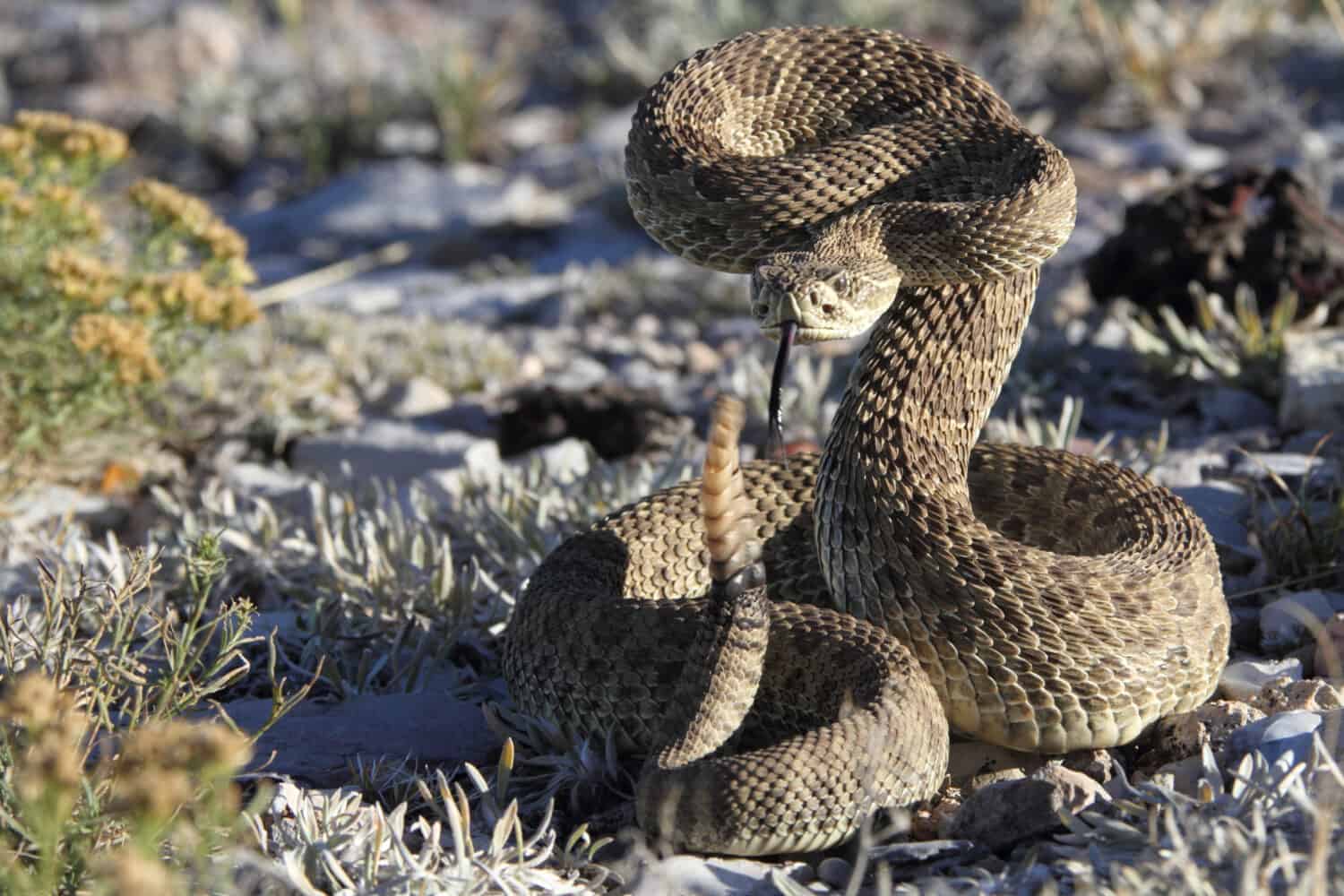Rattlesnakes are venomous snakes that are widely distributed throughout North America and South America. When encountering these pit vipers, it’s hard to not pay attention to their threat display that features the snake coiling while also shaking the rattles on their tails. However, what a person needs to be most worried about is how far a rattlesnake can strike and whether they are a safe distance from the snake. Learn the distance that these snakes can cover during a strike, how fast they can bite, and more!
How Far Can a Rattlesnake Strike?

The average rattlesnake can strike over a few feet away.
©Kevin Wells Photography/Shutterstock.com
A rattlesnake can strike at distances equal to 1/3 to 2/3 of its total body length, meaning a rattlesnake measuring 6 feet long can strike between 2 and 4 feet away. The snake’s ability to strike from so far away means that the safest place to be is beyond the snake’s total body length.
The following chart shows the rattlesnake’s hypothetical strike range based on the average size of these reptiles. Keep in mind that the snake’s strike range depends on many factors including species, size, and whether it is in a striking position before biting.
| Rattlesnake Length | Striking Range |
|---|---|
| 1ft | 4 to 8 inches |
| 2ft | 8 inches to 1 foot 4 inches |
| 3ft | 1 to 2 feet |
| 4ft | 1 to 2 feet 8 inches |
| 5ft | 1 foot 8 inches to 3 feet 4 inches |
| 6ft | 2 feet to 4 feet |
| 7ft | 2 feet 4 inches to 4 feet 8 inches |
| 8ft | 2 feet 8 inches to 5 feet 4 inches |
Not only can these snakes strike from a distance, but they can also strike with great accuracy and blinding speed. However, unless these snakes are feeling threatened, they are not going to strike. Rattlesnakes often take up a defensive posture to tell potential threats to leave them alone.
They’ll coil up and cause the rattles on their tails to vibrate. This threat display serves two purposes. For one thing, when the snake coils, it is positioning itself to deliver the farthest, fastest, and most accurate strike possible. The snake is also telling the threat to leave, possibly ending a confrontation before it begins. After all, the snakes just want to be left alone, and they certainly do not want to waste venom on something that they cannot eat.
Can a Rattlesnake Strike if Not Coiled?

Yes, a rattlesnake can strike even if it is not coiled into the familiar “S coil.” Although myths persist to the contrary, these snakes can and do attack without coiling. Also, they do not need to rattle to bite, either.
However, when they are not coiled, rattlesnakes cannot strike with the same distance or accuracy. That does not mean it is safe to be around an uncoiled rattlesnake, only that they are not in a position to strike from 2/3 of their body length while uncoiled.
Evidence of rattlesnakes biting while uncoiled is widely available in studies. For example, a study into pygmy rattlesnakes found that uncoiled snakes were more likely to strike than coiled ones. Sometimes, people surprise these snakes on a path while walking, and the snake strikes before it can assume its defensive posture.
Other times, rattlesnakes bite people when they are being held by their head and neck. Sometimes that occurs while humans are milking them for venom in a professional setting or simply when a person is mishandling them in the wild.
The bottom line is that these snakes can bite and strike when uncoiled, even if they cannot reach the same distance.
How Fast is a Rattlesnake Strike in Mph?

One study found that a rattlesnake strike occurs at about 6.29 mph.
©iStock.com/johnaudrey
According to a study from the University of Louisiana at Lafayette, rattlesnakes bite at a speed of 4.69 to 7.89 mph for an average of 6.29 mph. These snakebites have amazing speed and acceleration. Another study found that the first six inches of one specimen’s strike movement occurred in just 70 milliseconds. That means the snake can strike someone half a foot away faster than the human could blink!
So, if a person is in range of a rattlesnake’s bite and the snake wants to deliver a bite, speed is not a factor for the snake. They have such an advantage that even the fastest human could not move out of the way in time. The rattlesnake’s strike speed and distance are two reasons why people need to keep their distance from these snakes.
However, some animals can dodge snake strikes. The kangaroo rat is capable of sometimes anticipating and dodging a rattlesnake strike before the fatal blow can land. They are not always successful, though.
Can Rattlesnakes Bite Through Clothes?

Rattlesnakes can bite through a variety of shoes and boots.
©adriaticfoto/Shutterstock.com
Yes, rattlesnakes can bite through clothes. These reptiles have very sharp fangs that can measure a few inches long. Although they are hollow, the fangs can puncture through many materials, especially if it is tight-fitting on a person’s body. The fangs will easily penetrate the average t-shirt, shorts, and shoes.
Some materials offer a fair amount of protection in the event of a rattlesnake bite. For example, high-quality, heavy denim jeans can reduce the likelihood of rattlesnake venom being introduced into a human’s body. Also, while rattlesnakes can bite through thin leather boots, footwear made from thick leather or rubber pose a much greater challenge for a snake to bite through.
Of course, the goal is to stay as far away from rattlesnakes as possible. However, if a person is working or hiking in areas with rattlesnakes, it’s best to dress for the part. Never use high-quality clothing as an excuse to get closer to a rattlesnake than you would without such protection, though.
Knowing how far a rattlesnake can strike will give you a good idea of how far to stay away from these reptiles. If you’re closer than the snake’s body length, you’re in an area of potential danger. Still, keep in mind that these snakes do not want to bite you. They just want you to move along and leave them alone. Rattlesnakes do not chase people down and bite them, so there is no reason to panic should you merely see one from a distance.
Discover the "Monster" Snake 5X Bigger than an Anaconda
Every day A-Z Animals sends out some of the most incredible facts in the world from our free newsletter. Want to discover the 10 most beautiful snakes in the world, a "snake island" where you're never more than 3 feet from danger, or a "monster" snake 5X larger than an anaconda? Then sign up right now and you'll start receiving our daily newsletter absolutely free.
Thank you for reading! Have some feedback for us? Contact the AZ Animals editorial team.








